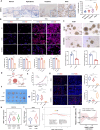DNMT1-targeting remodeling global DNA hypomethylation for enhanced tumor suppression and circumvented toxicity in oral squamous cell carcinoma
- PMID: 38755637
- PMCID: PMC11097543
- DOI: 10.1186/s12943-024-01993-1
DNMT1-targeting remodeling global DNA hypomethylation for enhanced tumor suppression and circumvented toxicity in oral squamous cell carcinoma
Abstract
Background: The faithful maintenance of DNA methylation homeostasis indispensably requires DNA methyltransferase 1 (DNMT1) in cancer progression. We previously identified DNMT1 as a potential candidate target for oral squamous cell carcinoma (OSCC). However, how the DNMT1- associated global DNA methylation is exploited to regulate OSCC remains unclear.
Methods: The shRNA-specific DNMT1 knockdown was employed to target DNMT1 on oral cancer cells in vitro, as was the use of DNMT1 inhibitors. A xenografted OSCC mouse model was established to determine the effect on tumor suppression. High-throughput microarrays of DNA methylation, bulk and single-cell RNA sequencing analysis, multiplex immunohistochemistry, functional sphere formation and protein immunoblotting were utilized to explore the molecular mechanism involved. Analysis of human samples revealed associations between DNMT1 expression, global DNA methylation and collaborative molecular signaling with oral malignant transformation.
Results: We investigated DNMT1 expression boosted steadily during oral malignant transformation in human samples, and its inhibition considerably minimized the tumorigenicity in vitro and in a xenografted OSCC model. DNMT1 overexpression was accompanied by the accumulation of cancer-specific DNA hypomethylation during oral carcinogenesis; conversely, DNMT1 knockdown caused atypically extensive genome-wide DNA hypomethylation in cancer cells and xenografted tumors. This novel DNMT1-remodeled DNA hypomethylation pattern hampered the dual activation of PI3K-AKT and CDK2-Rb and inactivated GSK3β collaboratively. When treating OSCC mice, targeting DNMT1 achieved greater anticancer efficacy than the PI3K inhibitor, and reduced the toxicity of blood glucose changes caused by the PI3K inhibitor or combination of PI3K and CDK inhibitors as well as adverse insulin feedback.
Conclusions: Targeting DNMT1 remodels a novel global DNA hypomethylation pattern to facilitate anticancer efficacy and minimize potential toxic effects via balanced signaling synergia. Our study suggests DNMT1 is a crucial gatekeeper regarding OSCC destiny and treatment outcome.
Keywords: DNA methylation; DNMT1; Insulin feedback; Neoplastic transformation; Oral squamous cell carcinoma; PI3K; Pharmacological toxicity; Tumor growth.
© 2024. The Author(s).
Conflict of interest statement
The authors declare no competing interests.
Figures









Similar articles
-
LDOC1 silenced by cigarette exposure and involved in oral neoplastic transformation.Oncotarget. 2015 Sep 22;6(28):25188-201. doi: 10.18632/oncotarget.4512. Oncotarget. 2015. PMID: 26317789 Free PMC article.
-
Hypomethylation-associated Sox11 upregulation promotes oncogenesis via the PI3K/AKT pathway in OLP-associated OSCC.J Cell Mol Med. 2024 Jul;28(14):e18556. doi: 10.1111/jcmm.18556. J Cell Mol Med. 2024. PMID: 39039706 Free PMC article.
-
Inhibitor of Growth 4 (ING4) Plays a Tumor-repressing Role in Oral Squamous Cell Carcinoma via Nuclear Factor Kappa-B (NF-kB)/DNA Methyltransferase 1 (DNMT1) Axis-mediated Regulation of Aldehyde Dehydrogenase 1A2 (ALDH1A2).Curr Cancer Drug Targets. 2022;22(9):771-783. doi: 10.2174/1568009622666220406104732. Curr Cancer Drug Targets. 2022. PMID: 35388759
-
Non-nucleoside inhibitors of DNMT1 and DNMT3 for targeted cancer therapy.Pharmacol Res. 2024 Sep;207:107328. doi: 10.1016/j.phrs.2024.107328. Epub 2024 Jul 28. Pharmacol Res. 2024. PMID: 39079576 Review.
-
5-Aza-4'-thio-2'-deoxycytidine, a New Orally Bioavailable Nontoxic "Best-in-Class": DNA Methyltransferase 1-Depleting Agent in Clinical Development.J Pharmacol Exp Ther. 2021 Nov;379(3):211-222. doi: 10.1124/jpet.121.000758. Epub 2021 Sep 9. J Pharmacol Exp Ther. 2021. PMID: 34503994 Free PMC article. Review.
Cited by
-
Molecular and Genetic Pathogenesis of Oral Cancer: A Basis for Customized Diagnosis and Treatment.Biology (Basel). 2025 Jul 10;14(7):842. doi: 10.3390/biology14070842. Biology (Basel). 2025. PMID: 40723400 Free PMC article. Review.
-
Aberrant DNMT1-mediated DACH1 methylation is associated with colorectal adenoma-to-carcinoma progression.Exp Biol Med (Maywood). 2025 Apr 30;250:10469. doi: 10.3389/ebm.2025.10469. eCollection 2025. Exp Biol Med (Maywood). 2025. PMID: 40370966 Free PMC article.
-
Persistent accumulation of therapy-induced senescent cells: an obstacle to long-term cancer treatment efficacy.Int J Oral Sci. 2025 Aug 1;17(1):59. doi: 10.1038/s41368-025-00380-w. Int J Oral Sci. 2025. PMID: 40750580 Free PMC article. Review.
-
Curcumin and neuroplasticity: epigenetic mechanisms underlying cognitive enhancement in aging and neurodegenerative disorders.Front Aging Neurosci. 2025 Aug 7;17:1592280. doi: 10.3389/fnagi.2025.1592280. eCollection 2025. Front Aging Neurosci. 2025. PMID: 40851668 Free PMC article. Review.
-
Comprehensive analysis of the pituitary tumor-transforming gene (PTTG) family in lung adenocarcinoma: diagnostic, prognostic, and therapeutic implications.Am J Transl Res. 2024 Nov 15;16(11):6326-6345. doi: 10.62347/TSJB6900. eCollection 2024. Am J Transl Res. 2024. PMID: 39678599 Free PMC article.
References
MeSH terms
Substances
Grants and funding
LinkOut - more resources
Full Text Sources
Medical
Molecular Biology Databases

